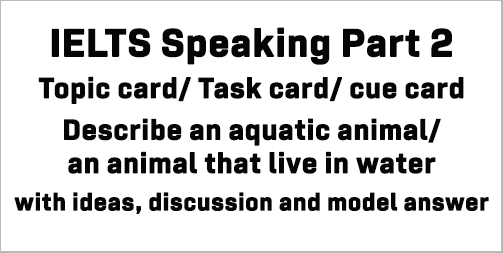In this IELTS Speaking Part 2 post, I’m going to discuss and provide a cue card of Speaking Part 2 of the IELTS test. Here, I’m going to describe a model answer for the topic of an aquatic animal/ an animal that lives in water. You will find a short discussion on how to prepare yourself for the cue card as well as some notes that will help you speak fluently. You will also get some part-3 questions at the end of the post.
A short discussion on the topic card:
Before you start speaking, you should jot down some ideas for the topic card.
Here are some notes that may help you speak fluently:
Think about the word ‘aquatic’. Have you ever heard this word before?
‘Aqua’ means ‘water’. So, ‘aquatic animal’ means ‘an animal that lives in water’. So, we can talk about crocodiles, whales, seals, hippos, dolphins, octopuses, starfish, even frogs.
We are going to describe ‘a crocodile’ for this cue card.
Add the following information in your speaking part 2 answer:
- crocodile
- during childhood
- visit to a safari park
- first encounter
- learned about it before field trip from teacher
- survived the asteroid strike that wiped out the dinosaur population
- reptiles, cold-blooded, thriving predators, looks fearsome,
- webbed feet, fast swimmer, streamlined body, lives 50 to 80 years
Model answer:
Although I live in a place where aquatic regions such as rivers, ponds, and lakes may be found all around the country, I am only vaguely familiar with aquatic critters. Anyway, the few aquatic species I’m familiar with are whales, seals, crocodiles, and dolphins, and I’m going to talk about crocodiles today.
The first time I saw a crocodile was on a college trip to a national animal sanctuary in Bangladesh’s Chattagram Hill Tracks, in the south-eastern section of the country. A place named Dulahazra Safari Park is where I had my first ever contact with a crocodile, among many other native and international species.
Miss Jesmin, our teacher, gave us an overview of what we could see at the safari park for the first time before the tour, as I recall. She detailed a variety of species, but the crocodile was the most intriguing to me. It’s because she said that crocodiles are one of the few species known to have survived the asteroid that hit the earth over 250 million years ago and killed out the dinosaurs. They survived the catastrophic extinction and continued to thrive for hundreds of millions of years. So it’s reasonable to say that their history on Earth is long and mysterious!
Crocodiles are reptiles, which means they have a backbone, are cold-blooded, and have dry, scaly skin. They are sometimes referred to as “living fossils” because they have been on Earth since the dinosaurs.
Despite the fact that they have been there for millions of years, their bodies have not changed much because they are such thriving predators and appear to be terrifying.
Crocodiles have very pointed snouts, which distinguishes them from their alligator cousins, and their upper and lower jaws are the same size. Crocodiles have webbed feet that help them swim quickly. Their bodies are also incredibly streamlined, allowing them to glide through the water fast to catch their food. Crocodiles vary in height and weight, but some can grow to be over 23 feet long and weigh over 2,200 pounds, with a lifespan of 50 to 80 years.
That’s all.
Part 3 questions:
- Why do people like to keep pets?
- What should we do to protect endangered animals?
- Do you support doing experiments on animals?
- Why do some people refuse to eat animals?
- What would happen when some species disappear on earth?
Here are model answers to some other speaking topic cards for your preparation:
Describe a beautiful building in your city
A sport or exercise that you do for fitness
Describe a handsome person you know
Describe someone you know who does something well
Describe a situation when you were late
Describe an important decision made by you
Describe the best gift or present you have received
Describe something that helps you concentrate
Describe when someone gave you something you really wanted
Describe an advertisement you remember
Describe a newly built facility that improves the quality in your city

